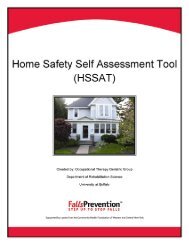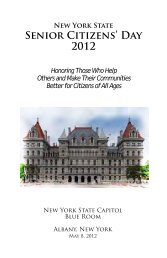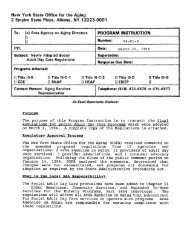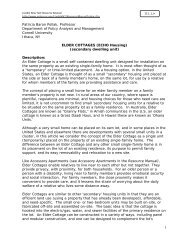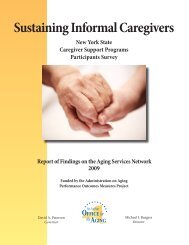White Paper - New York State Office for the Aging
White Paper - New York State Office for the Aging
White Paper - New York State Office for the Aging
- No tags were found...
You also want an ePaper? Increase the reach of your titles
YUMPU automatically turns print PDFs into web optimized ePapers that Google loves.
THE FACE OF NEW YORK – The People<br />
those older and those younger cohorts, providing much enhanced Boomer clout in <strong>the</strong><br />
marketplace, <strong>the</strong> voting booth, public policy, and all those areas of government concern.<br />
Additionally, <strong>the</strong> growing racial, ethnic, religious, and ideological diversity cited so often<br />
today will be far more obvious, not just in faraway cities or states, but actually within <strong>the</strong><br />
families of <strong>the</strong> children of <strong>the</strong> Boomers, because <strong>the</strong>re will be many more so-called<br />
“mixed marriages” across all <strong>the</strong> lines just noted and children and grandchildren will be<br />
of vast combinations of backgrounds. These characteristics will be very valuable and<br />
beneficial as more and more Americans work within <strong>the</strong> global economy, use <strong>the</strong> Internet<br />
<strong>for</strong> cross national communication, and travel throughout <strong>the</strong> world in increasing numbers.<br />
Our national diversity will enable greater understanding of o<strong>the</strong>r cultures and nations and<br />
will make <strong>the</strong> process of international integration both feasible and desirable.<br />
As <strong>the</strong>se changes occur, and since Boomers and <strong>the</strong>ir contemporaries also will be<br />
growing older, aging community leaders will not seem “so old,” nor will <strong>the</strong>y be as<br />
threatening as <strong>the</strong>y once were when <strong>the</strong> Baby Boomers were younger and said “never<br />
trust anyone over 30.” In 2015, age as a defining variable will seem less relevant because<br />
those positions of community prestige and political power will be concentrated in <strong>the</strong><br />
hands of middle-aged and early retirement Boomers. At <strong>the</strong> same time, <strong>the</strong>re will be<br />
many emergent responsibilities that will shape <strong>the</strong> lifestyles of <strong>the</strong> Boomers. Many will<br />
be trying to cope with aging parents, those very people who provided such indulgence<br />
and freedom when <strong>the</strong>y were growing up. It is always difficult to watch your elders<br />
become more elderly, but <strong>for</strong> people who hoped <strong>for</strong> eternal youth, this experience will be<br />
both frustrating and in ways frightening. The physical declines that come with age will<br />
occur regardless of most of <strong>the</strong> now exciting new treatments and advertising promises.<br />
Watching such declines happen to one’s own parents will rein<strong>for</strong>ce <strong>the</strong> realization that “I,<br />
too, am mortal,” making many Boomers hope <strong>for</strong> more promises <strong>for</strong> <strong>the</strong>mselves. The<br />
demands of <strong>the</strong> Elder Boom will continue to push <strong>the</strong> envelope <strong>for</strong> increased and<br />
improved health care, short- and long-term aging care, and parental care. These demands<br />
will bring about many new initiatives, none of which is actually likely to stop or reverse<br />
<strong>the</strong> aging process, but certainly <strong>the</strong>y are likely to help make <strong>the</strong> process easier and more<br />
people-oriented. These changes will exact a price from younger generations that follow,<br />
and eventually it will have to be balanced from a societal perspective.<br />
The Baby Boom cohort was raised to believe that <strong>the</strong>y did not have to accept<br />
existing, long-standing solutions to life’s vicissitudes. As <strong>the</strong> Boomers were growing up,<br />
many institutions came under fire, partly because <strong>the</strong>ir parents were committed to<br />
providing “non-Depression, non-Wartime” lives <strong>for</strong> <strong>the</strong>ir children, but also because <strong>the</strong><br />
sheer numbers were over-taxing <strong>the</strong> existing social institutions of <strong>the</strong> time. Specifically,<br />
vast changes were wrought to <strong>the</strong> schools of <strong>the</strong> era; teenage sexual restrictions became<br />
passe and in many instances largely irrelevant; compulsory military service became a<br />
burden too unbearable to allow. The protocols <strong>for</strong> work shifted massively, paving <strong>the</strong><br />
way <strong>for</strong> a new world of leisure time activities; many religious institutions were altered to<br />
make <strong>the</strong>m “more relevant.” Meanwhile, <strong>the</strong> Boomers marched on, leading <strong>the</strong> social<br />
revolution of <strong>the</strong> late 20 th century.<br />
16



